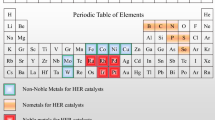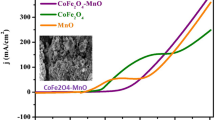Abstract
Modification of electrode surface with carboxylic acid terminated alkanethiol self-assembled monolayers (SAMs) has been found to be an effective approach to improve the extracellular electron transfer (EET) of electrochemically active bacteria (EAB) on electrode surface, but the underlying mechanism behind such enhanced EET remains unclear. In this work, the gold electrodes modified by mercapto-acetic acid and mercaptoethylamine (Au-COOH, Au-NH2) were used as anodes in microbial electrolysis cells (MECs) inoculated with Geobacter sulfurreducens DL-1, and their electrochemical performance and the bacteria-electrode interactions were investigated. Results showed that the Fe(CN) 3–/4–6 redox reaction occurred on the Au-NH2 with a higher rate and a lower resistance than that on the Au or the Au-COOH. Both the MECs with the Au-COOH and Au-NH2 anodes exhibited a higher current density than that with a bare Au anode. The biofilm formed on the Au-COOH was denser than that on bare Au, while the biofilm on the Au-NH2 had a greater thickness, suggesting a critical role of direct EET in this system. This work suggests that functional groups such as–COOH and-NH2 could promote electrode performance by accelerating the direct EET of EAB on electrode surface.
Similar content being viewed by others
References
Rittmann B E, Krajmalnik-Brown R, Halden R U. Pre-genomic, genomic and post-genomic study of microbial communities involved in bioenergy. Nature Reviews. Microbiology, 2008, 6(8): 604–612
Ishii S, Suzuki S, Norden-Krichmar T M, Tenney A, Chain P S G, Scholz M B, Nealson K H, Bretschger O. A novel metatranscriptomic approach to identify gene expression dynamics during extracellular electron transfer. Nature Communications, 2013, 4: 1601
Yuan S J, Li W W, Cheng Y Y, He H, Chen J J, Tong Z H, Lin Z Q, Zhang F, Sheng G P, Yu H Q. A plate-based electrochromic approach for the high-throughput detection of electrochemically active bacteria. Nature Protocols, 2014, 9(1): 112–119
Logan B E. Exoelectrogenic bacteria that power microbial fuel cells. Nature Reviews. Microbiology, 2009, 7(5): 375–381
Zang G L, Sheng G P, Tong Z H, Liu X W, Teng S X, LiWW, Yu H Q. Direct electricity recovery from Canna indica by an air-cathode microbial fuel cell inoculated with rumen microorganisms. Environmental Science & Technology, 2010, 44(7): 2715–2720
Sun M, Zhang F, Tong Z H, Sheng G P, Chen Y Z, Zhao Y, Chen Y P, Zhou S Y, Liu G, Tian Y C, Yu H Q. A gold-sputtered carbon paper as an anode for improved electricity generation from a microbial fuel cell inoculated with Shewanella oneidensis MR-1. Biosensors & Bioelectronics, 2010, 26(2): 338–343
Wang A J, Cheng H Y, Ren N Q, Cui D, Lin N,WuW M. Sediment microbial fuel cell with floating biocathode for organic removal and energy recovery. Frontiers of Environmental Science & Engineering, 2012, 6(4): 569–574
Bond D R, Holmes D E, Tender L M, Lovley D R. Electrodereducing microorganisms that harvest energy from marine sediments. Science, 2002, 295(5554): 483–485
Kouzuma A, Hashimoto K, Watanabe K. Roles of siderophore in manganese-oxide reduction by Shewanella oneidensis MR-1. FEMS Microbiology Letters, 2012, 326(1): 91–98
Torres C I, Marcus A K, Lee H S, Parameswaran P, Krajmalnik- Brown R, Rittmann B E. A kinetic perspective on extracellular electron transfer by anode-respiring bacteria. FEMS Microbiology Reviews, 2010, 34(1): 3–17
Liu H, Newton G J, Nakamura R, Hashimoto K, Nakanishi S. Electrochemical characterization of a single electricity-producing bacterial cell of Shewanella by using optical tweezers. Angewandte Chemie International Edition, 2010, 49(37): 6596–6599
Marsili E, Baron D B, Shikhare I D, Coursolle D, Gralnick J A, Bond D R. Shewanella secretes flavins that mediate extracellular electron transfer. Proceedings of the National Academy of Sciences of the United States of America, 2008, 105(10): 3968–3973
Gorby Y A, Yanina S, McLean J S, Rosso K M, Moyles D, Dohnalkova A, Beveridge T J, Chang I S, Kim B H, Kim K S, Culley D E, Reed S B, Romine M F, Saffarini D A, Hill E A, Shi L, Elias D A, Kennedy D W, Pinchuk G,Watanabe K, Ishii S, Logan B, Nealson K H, Fredrickson J K. Electrically conductive bacterial nanowires produced by Shewanella oneidensis strain MR-1 and other microorganisms. Proceedings of the National Academy of Sciences of the United States of America, 2006, 103(30): 11358–11363
Huang Y X, Liu X W, Xie J F, Sheng G P, Wang G Y, Zhang Y Y, Xu A W, Yu H Q. Graphene oxide nanoribbons greatly enhance extracellular electron transfer in bio-electrochemical systems. Chemical communications (Cambridge, England), 2011, 47(20): 5795–5797
Liu X W, Sun X F, Chen J J, Huang Y X, Xie J F, LiWW, Sheng G P, Zhang Y Y, Zhao F, Lu R, Yu H Q. Phenothiazine derivativeaccelerated microbial extracellular electron transfer in bioelectrochemical system. Scientific Reports, 2013, 3: 1616
Crittenden S R, Sund C J, Sumner J J. Mediating electron transfer from bacteria to a gold electrode via a self-assembled monolayer. Langmuir, 2006, 22(23): 9473–9476
Lowy D A, Tender L M, Zeikus J G, Park D H, Lovley D R. Harvesting energy from the marine sediment-water interface II. Kinetic activity of anode materials. Biosensors & Bioelectronics, 2006, 21(11): 2058–2063
Stams A J M, de Bok F A M, Plugge C M, van Eekert M H A, Dolfing J, Schraa G. Exocellular electron transfer in anaerobic microbial communities. Environmental Microbiology, 2006, 8(3): 371–382
Tarlov M J, Bowden E F. Electron-transfer reaction of cytochrome c adsorbed on carboxylic acid terminated alkanethiol monolayer electrodes. Journal of the American Chemical Society, 1991, 113(5): 1847–1849
Chen X, Ferrigno R, Yang J, Whitesides G M. Redox properties of cytochrome c adsorbed on self-sssembled monolayers: a probe for protein conformation and orientation. Langmuir, 2002, 18(18): 7009–7015
Ostuni E, Chapman R G, Liang M N, Meluleni G, Pier G, Ingber D E, Whitesides G M. Self-assembled monolayers that resist the adsorption of proteins and the adhesion of bacterial and mammalian cells. Langmuir, 2001, 17(20): 6336–6343
Wang G M, Qian F, Saltikov C, Jiao Y Q, Li Y. Microbial reduction of graphene oxide by Shewanella. Nano Research, 2011, 4(6): 563–570
Richter H, McCarthy K, Nevin K P, Johnson J P, Rotello V M, Lovley D R. Electricity generation by Geobacter sulfurreducens attached to gold electrodes. Langmuir, 2008, 24(8): 4376–4379
Wang H T, Zhao H M, Quan X. Gold modified microelectrode for direct tetracycline detection. Frontiers of Environmental Science & Engineering, 2012, 6(3): 313–319
Liu S Y, Liu G, Tian Y C, Chen Y P, Yu H Q, Fang F. An innovative microelectrode fabricated using photolithography for measuring dissolved oxygen distributions in aerobic granules. Environmental Science & Technology, 2007, 41(15): 5447–5452
Bain C D, Troughton E B, Tao Y T, Evall J, Whitesides G M, Nuzzo R G. Formation of monolayer films by the spontaneous assembly of organic thiols from solution onto gold. Journal of the American Chemical Society, 1989, 111(1): 321–335
Bard A J, Faulkner L R. Electrochemical Methods: Fundamentals and Applications. 2nd ed. New York: Wiley, 2001
Khan M M T, Ista L K, Lopez G P, Schuler A J. Experimental and theoretical examination of surface energy and adhesion of nitrifying and heterotrophic bacteria using self-assembled monolayers. Environmental Science & Technology, 2011, 45(3): 1055–1060
Author information
Authors and Affiliations
Corresponding author
Rights and permissions
About this article
Cite this article
Zhang, F., Yu, S., Li, J. et al. Mechanisms behind the accelerated extracellular electron transfer in Geobacter sulfurreducens DL-1 by modifying gold electrode with self-assembled monolayers. Front. Environ. Sci. Eng. 10, 531–538 (2016). https://doi.org/10.1007/s11783-015-0793-y
Received:
Accepted:
Published:
Issue Date:
DOI: https://doi.org/10.1007/s11783-015-0793-y




